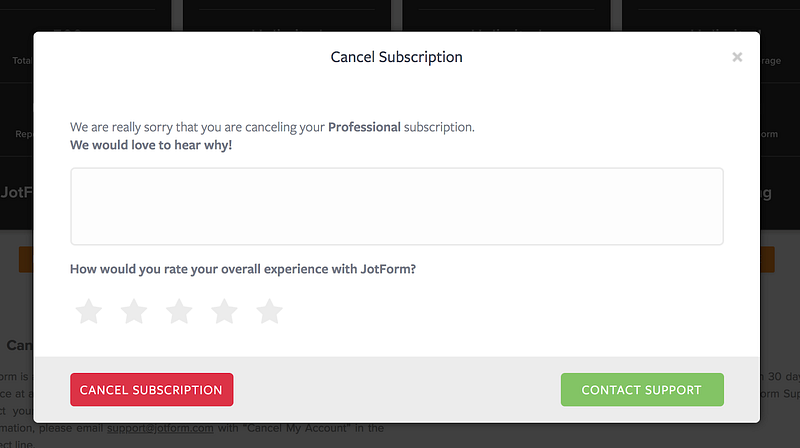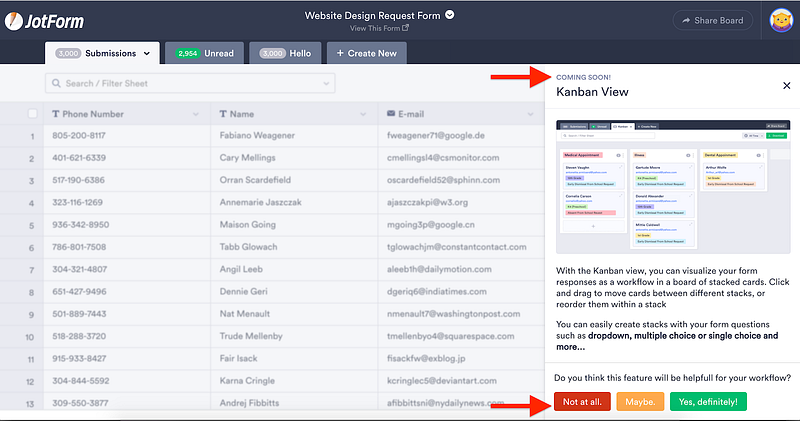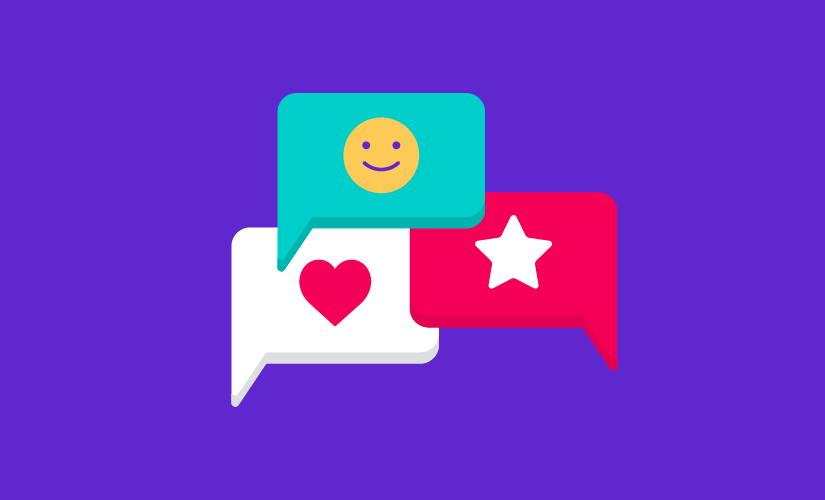We have 3.5 million users.
That’s 3.5 million people who have opinions about Jotform. People who can give us invaluable feedback on what features to build, updates to push, and pages to redesign.

But only if we know how to listen to them.
This is easier said than done. As Ralph G. Nichols and Leonard A. Stevens wrote in a Harvard Business Review article:
“People in general do not know how to listen.
They have ears that hear very well, but seldom have they acquired the necessary aural skills which allow those ears to be used effectively for what is called listening.”
Hearing and listening are not the same.
Unlike just hearing, listening requires us to interpret and understand what is being said.
We need to know not just what words somebody has said, but what they meant by them.
Listening requires more attention. It also requires humility if you’re listening to criticism.
It’s easy to dismiss “haters” or “trolls” who talk negatively about your business, but tuning out opposing viewpoints doesn’t make them go away.
There is always something to learn from the perspectives of people we disagree with.
In his 2013 Ted Talk, Intel’s Tony Salvador explains how, when we want to create a product, everything we hear is “through the lens of the product we actually want to build.”
We hear their feedback, but we don’t really listen to what they’re saying.
Salvador describes how companies choose not to focus on negative feedback and then release a product anyway. He explains what happens next:
“It doesn’t sell and we’re surprised because we actually got good customer feedback. Not really a good plan.
A better way is to figure out how to actually listen better.”
Across 12 years of building Jotform, we’ve had some hard lessons that taught us how to properly handle feedback.
Before I explain how to improve your effective listening, I want to share a few real life examples of how we listen to our 3.5 million users, not just hear them:
1. Listening to your customers while releasing new features
Last year, we spent 326 days on a massive product release, aka Jotform Cards.
Every time we work on such a big launch, we keep the big reveal under wraps, but we show our new product or version to a small test group.
We start with 1% of our user base and gradually build to 10%.
This system helps us to gather effective feedback, root out problems, and compare the new version to previous iterations (if you have them).
Contained testing is essential — and it’s the best way to polish your release by listening to a small percentage of your users effectively without risking to frustrate all of them.
2. Interpreting why a customer actually wants to leave
It’s always disappointing when somebody cancels a subscription for your product. However, you can gain valuable insights when this happens.
When customers cancel their subscriptions, we ask them why they cancel and collect their feedback through a simple form. We then try to understand and interpret their feedback.

In many cases, they are leaving due to an issue we can easily resolve. In these circumstances, we contact the user directly via email and are able to get them back.
You shouldn’t wait until they are about to cancel, though.
I’ve recently explained why customer service is the new marketing which is exactly why our customer support team goes beyond handling open tickets.
For instance, if a user mentions a new feature request in a support thread, our customer agent takes care of bridging the innovation between the customer and respective development team.
On the other hand, our marketing and UX teams continuously conduct interviews with users, collect text feedback, and video record them to create case studies.
3) Listening by showing upcoming feature requests
No matter how effectively we listen, chances are there will always be a few users unhappy with the new version or a feature release.
This is one of the reasons why, once we release a new version, we try to give our users the ability to use the older version.
In addition, we’re now developing a new component to show them our upcoming features. This is where we’ll display mockups of new features and ask users whether they would like this new feature.

We want feedback from users regarding planned features so we don’t waste time creating something they don’t want.
It’s not about guessing what users want.
It’s about effective listening.
Now that I’ve shared some examples applied to business, I’d like to explain in detail the importance of effective listening and how we can improve it both in real life and our businesses.
What is effective listening?
Effective listening means you’ve fully absorbed what the speaker has said and made them feel understood.
In a study that analyzed the listening skills of hundreds of businessmen and students, the results were disappointing.
Immediately after “listening,” participants only remembered about 50% of what they had heard.
Half a year later, it dropped to 25%.
Often when we hear someone speak, we’re mostly focusing on how to respond when they’re finished. According a Farnham Street article,
“Listening is difficult because it involves suppressing your ego long enough to consider what is being said before you respond.”
So how do we suppress our egos and go from just hearing to active listening? Let’s start with what not to do.
What to avoid when listening
- Don’t overuse of the word “I.” Author Tom Shachtman wrote, “The most frequently used written word in the language is ‘the,’ but the most frequently spoken word…is ‘I.’” Keep the focus on the person speaking and don’t shift it onto yourself.
- Don’t interrupt. Put your ego aside and don’t assume you know what a person is going to say. Interrupting sends the message, “My words are more accurate or interesting than yours.” As lyrics by The Dynamos state, “The sound of our voices keep us from listening … We never intend to hear what each other say.”
- Don’t multitask. As psychiatrist M. Scott Peck explains, “You cannot truly listen to anyone and do anything else at the same time.” If you’re speaking in person, make eye contact. If you’re chatting or interviewing users online, focus on your response — not something happening in the room.
- Don’t be silent. Conversations are meant to go both directions. When the person has finished speaking, it’s natural to respond. You might say “It sounds like…” or “I’ve noticed that…”

How to be an effective listener
- Do ask questions. Asking questions shows you understood what a person said as well as that you care to learn more. Try sentences like “Do you mean…?” or “Really?”
- Do be empathetic. Try to understand how a person feels about what they are telling you. Ask them questions about their emotions. Sometimes, people just want their feelings acknowledged. Make a safe space where they feel comfortable sharing. Remember it’s about their emotions — not yours.
- Do stay on topic. We’ve all had conversations where we desperately want to talk about something, but are disappointed when the conversation goes another direction. If you accidentally lead a conversation away from the speaker’s intended topic, help to steer it back on track.
- Do make suggestions. This is a tricky one. Harvard analyzed data of participants in a program created to help managers improve their coaching skills. They discovered that those ranked as the most effective listeners tended to make suggestions. Just make sure you’ve checked all the other boxes before trying this one.
Moving Forward
The truth is, we all could improve our listening skills especially when it comes to properly using feedback to improve our product.
Our hearing has evolved to ignore most sounds, unless something seems dangerous. If we tried to hear everything in our surrounding environment, we would be hopelessly overwhelmed.
We need to train ourselves to focus our attention on people talking to us. We’re constantly looking at ways to gain feedback as well as give our users easy means to seek it as well.
But it’s difficult.
We need to ask questions, be empathetic, and give suggestions.
Most importantly, we need to focus our attention completely on another person, even if what they are saying is difficult to hear.
In summary, using Author Dean Jackson’s words:
“Listening is an art that requires attention over talent, spirit over ego, others over self.”









































































Send Comment:
2 Comments:
More than a year ago
The true meaning of conversation
Of course is the individual listening. But wanting to here you
PRo or con. Sir speaking is listening I’ve always learned more from my eyes and ears.
More than a year ago
Ur. Qs on speaking are completely correct I’ve never been here before tryed to give opinion but a little illerate on vocabulary actually but my voice is honestly straight shooting even if you don’t like it.
Billy Thorp. 3522125963.
Good Morning